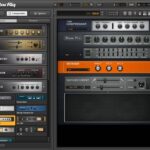 At long last, after two years of work, Ginny Owens‘ new album, Get In, I’m Driving, which I produced along with Ginny and Monroe Jones, was released today. Visit iTunes, Amazon, or Amazon MP3 to hear more.
At long last, after two years of work, Ginny Owens‘ new album, Get In, I’m Driving, which I produced along with Ginny and Monroe Jones, was released today. Visit iTunes, Amazon, or Amazon MP3 to hear more.
I’ve previously written articles showing some of the behind-the-scenes development of a few of the songs (Before You Fly and the title track Get In I’m Driving) from the album, where I showed each respective song from its genesis then chronicled its development and evolution through the production process. For today’s Songblog, we’ll look at Lay It Down, but in reverse. We’ll start with the finished version, then deconstruct it into its component pieces.
Lay It Down is much more of a hybrid R&B/hip hop track than the other two we looked at, although we mixed in some pop elements too.
There’s a lot of programming (loops, synths) that form the bedrock of the song. Producing a song in this style is less about performing great virtuosic parts, and more about choosing simple elements that lock well together and create the overall groove that we’re going for.
Here’s a look at the root of the rhythm section, the drums. The first half of this clip is a custom-programmed loop that’s used mostly in the verse of the song, then mixed in with some tambourine to keep the motion going. The second half of this clip adds another loop of a live drummer playing on the ride cymbal, which adds a vintage-live air to it:
 But there’s one more percussive element I added to the chorus: an acoustic drum kit. The part was fairly simple so it wasn’t necessary to bring in a live drummer, so this kit was programmed using XLN Audio’s wonderful Addictive Drums, and I chose a dirty garage-style kit with lots of room mic, then laid this drum part on top of the ones in the previous clip:
But there’s one more percussive element I added to the chorus: an acoustic drum kit. The part was fairly simple so it wasn’t necessary to bring in a live drummer, so this kit was programmed using XLN Audio’s wonderful Addictive Drums, and I chose a dirty garage-style kit with lots of room mic, then laid this drum part on top of the ones in the previous clip:
So, taking the sum of all those drum parts, here’s a clip of the complete drum mix in the chorus of the song, which takes brings all those elements together:
 Let’s look at the bass. The bass plays a pretty distinctive riff, but it’s not just the notes that are being played but also the distinctive sound of the bass that gives it its character. Usually, a part like this might be played by a synth bass, but I preferred to play it on a real Epiphone bass to give it more human nuance. Here’s the finished bass riff, isolated, and you’ll clearly hear lots of ugly dirty finger noise that I think gives it a special quality:
Let’s look at the bass. The bass plays a pretty distinctive riff, but it’s not just the notes that are being played but also the distinctive sound of the bass that gives it its character. Usually, a part like this might be played by a synth bass, but I preferred to play it on a real Epiphone bass to give it more human nuance. Here’s the finished bass riff, isolated, and you’ll clearly hear lots of ugly dirty finger noise that I think gives it a special quality:
 The bass obviously has a lot of processing on it. To get this overdriven bass tone, I used Native Instruments Guitar Rig and designed a patch with heavy tube compression, a midrange EQ bump, and an octaver, which you can see in the screenshot. Because the octaver adds the octave below, I had to play the riff one octave up. Here’s a clip of the dry bass part with no processing:
The bass obviously has a lot of processing on it. To get this overdriven bass tone, I used Native Instruments Guitar Rig and designed a patch with heavy tube compression, a midrange EQ bump, and an octaver, which you can see in the screenshot. Because the octaver adds the octave below, I had to play the riff one octave up. Here’s a clip of the dry bass part with no processing:
Moving beyond bass and drums, several other instruments occupy the middle ground between the core rhythm section and the vocals, but they are sparse. The signature Rhodes sound is constant through the song, and it’s a simple arpeggiated part which I purposely played a little bit loose. The Rhodes was passed through a 70’s British guitar amp and also EQ’ed (rolling off all the low end) to give it a more brittle texture:
 There are some B3 punctuations that come in and out of the song here and there. For this, I used the Native Instruments B4 softsynth, one of my favorites:
There are some B3 punctuations that come in and out of the song here and there. For this, I used the Native Instruments B4 softsynth, one of my favorites:
There’s also some piano with a stereo ping-pong delay that adds a little contrast in the prechorus:
And for some icing on the cake, there’s some high strings added to the chorus. They’re playing very simple whole notes, but they really elevate the chorus:
In the chorus, I felt like the song really needed a little more of a pop flavor, so I called in my friend and session guitarist Kip Haynes who added some Maroon 5-like guitars to the chorus that gave it a lot more lift and bounce. He recorded two slightly different guitar parts, which in the mix we ended up hard-panning left and right:
Ginny ended up adding a dozen or so tracks of background vocals, which really support the vocal well. In the final mix, the background vocals are actually more prominent than the rest of the band, which gives the production (which is pretty electronic for the most part) much more of an organic feel. Here’s the clip of the BGV’s isolated:
So in the above clips, I’ve isolated every element of the song. Once recombined, you can now hear it all come together in the full clip:
Since I said I’d deconstruct this song in reverse, this Songblog wouldn’t be complete without a look at where the song started. With Ginny’s permission, here’s a short clip of the very original songwriting demo she sent me. As you’ll hear, it’s pretty barebones, which is typical during the songwriting process. Her focus is not so much on how it sounds, but on making sure words and melody are in their place:
If you enjoyed this article, be sure to check out other behind-the-scenes articles about this album on Before You Fly and Get In, I’m Driving. Keep an eye out for the full album (see it at iTunes or Amazon), which releases on September 13, 2011.





















